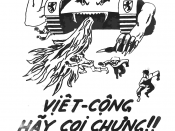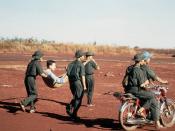During Kennedy's presidency from 1962, he sent over 16,000 military advisors to Vietnam including Green Berets to train South Vietnamese army defend themselves. When Kennedy was assassinated in 1963, his successor Lyndon Johnson became the new president. By 1964, 35% of South Vietnam was in Vietcong hands, communists, and 60,000 communist guerrillas operating in the South. Soon after the Gulf of Tonkin Incident on 2 August 1964 the US destroyer Maddox was fired by North Vietnamese and probably another destroyer Turner Joy later. This gave excuse to the US congress to pass the Gulf of Tonkin Resolution where allowed President Johnson a free hand to send military supplies, including troops, to Vietnam. The resolution led to an escalation of US involvement in the war. The number of troops increased rapidly, reaching 385,000 in 1966 and 535,000 in 1968, totally having 2.59 million Americans served in Vietnam from 1964 to 1975.
As the jungle nature of the country, the guerilla warfare strategies of the Vietcong and the difficulty to discriminate between North and South Vietnamese soldiers made Americans to have a hard time, they relied heavily on air raids and chemical weapons. Vietcong had weaponry supplied mostly from China and the USSR before, it was clearly not as forward as the US so the guerilla strategies were necessary. The US's combat power, therefore, was heavily limited to exfoliate chemical weapons like Napalm and Agent Orange to strip trees bare of leafs for better navigation, to destroy the local rice fields, and stop supporting Vietcong guerrillas in the South, as seen in Operation Rolling Thunder, initiated on February 13, 1965. However, the Tet offensive was a massive attack by the Vietcong upon South Vietnam began on 30th January 1968. All the major cities of South Vietnam were attacked, including Saigon. In Saigon,


